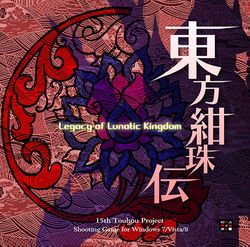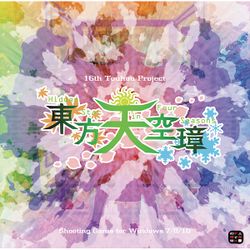잔글 (→OCEARIS-ETC) |
잔글 (→동프) |
||
| 429번째 줄: | 429번째 줄: | ||
천귀? | 천귀? | ||
| style="text-align: center;" | [[파일:Th16cover.jpg|250px|centre|link=동방천공장]] | | style="text-align: center;" | [[파일:Th16cover.jpg|250px|centre|link=동방천공장]] | ||
| style="text-align: center;" | [[ | | style="text-align: center;" | [[파일:th17cover.jpg|250px|centre|link=동방천공장]] | ||
| style="text-align: center;" | TH 18 예정 | | style="text-align: center;" | TH 18 예정 | ||
|- | |- | ||
2019년 7월 30일 (화) 14:55 판
한국말 연습장
나도 틀 쓸거야!!
| 나라 이름이 입력되지 않았습니다. | |
|---|---|
적용예시
| 아리아 리타스 | |
|---|---|
| 원어 명칭 | Litasa'Riana |
RAM
AFRIKAN
OCEARIS-ETC
| 오세아니아 | |
|---|---|
| 폴리네시아 |
|
| 기타 | |
FULL
※ 현재 쓰이지 않는 통화는 취소선 처리 ※ 계승 전 통화 및 예하 통화는 괄호처리로 병기. ※ 미승인국 및 자치령의 통화는 ‡를 붙임. (※본 둘러보기 상자는 2019년 7월 31일 이내로 분할 교체예정입니다.※) |
|
| 아시아 | |
| 아프리카 | |
| 유럽 | |
| 아메리카 | |
| 오세아니아 | |
| 기타 | |
ROM
iso 4217용 이미지링크 연습
고오오급 틀 써보자
동프
| 東方プロジェクト (동방프로젝트) | |||
|---|---|---|---|
| TH 06~08
홍요영 |
|||
| TH 10~12
풍지성 |
|||
| TH 13~15
신휘감 |
|||
| TH 16~18
천귀? |
TH 18 예정 | ||
| 췌몽상,
비상천/비상천칙 |
|||
| 심기루/심비록
빙의화 |
|||
日本語練習帳
目指せ、キーボー道マスター。
외부자료
- Tam mak houng (Papaya salad)
The casual observer might dismiss tam mak houng as being the papaya salad seen everywhere in Thailand, or similar dishes eaten in Cambodia or Vietnam. Interestingly enough, there’s some controversy as to where the papaya salad originated in Isaan, in northeastern Thailand, or in Laos. “…there’s some controversy as to where papaya salad originated…in Thailand or in Laos.” The first time I had it, I wasn’t watching the preparation very carefully and was surprised that it tasted completely different than the Bangkok version. I noticed immediately that it was saltier and grittier than its Thai cousin, with stronger notes of spice and salt, thanks to bpadek, , a fermented fish sauce. This Lao version of fish sauce is made from mud fish. The resulting product isn’t the clear amber color travelers know from Thai or Vietnamese cuisine, but a thick, dark opaque, (sometimes gritty or even chunky) liquid with a strong flavor that is something of an acquired taste. Another difference is found in the sweetness of the dish: palm sugar isn’t added to Lao papaya salad. A meal of sticky rice, slow-chicken or pork with a side of tam mak houng makes for a delicious, filling meal and shouldn’t set you back more than $2-3USD.
- Oh lam (Stew)
Originating from the Hmong of Luang Prabang, oh lam is a stew made mainly from vegetables: beans, eggplants, gourds, black mushrooms, then seasoned with lemongrass, chili, and coriander and finally thickened with sticky rice. Ho or Oh is loosely translated as “to put in”, which implies that this stew is a hodge-podge of whatever ingredients are on hand. But the key ingredient is sa kan, a bitter root herb. “Because it takes a long time to cook, oh lam is usually made for special ceremonies only.” Chef Deinla walked me through his version of oh lam and pointed out that the sa kan is basically the woody stem of a wild vine and not meant to be eaten. Instead, it can be chewed, releasing the astringent, almost peppery menthol, oils, and then spit out. Sometimes meat is included, most often water buffalo or crispy fried pork skin. Because it takes a long time to cook, oh lam is usually made for special ceremonies only. Kung told me, “Old people enjoy it people more than young people. They don’t have the time to make it.” It has a unique, earthy taste that I’ve never come across anywhere else in SE Asia.
- Laap (Meat salad)
Probably the best-known dish from Laos, laap is a chopped meat “salad” made of pork, chicken, beef, duck or fish, dressed with lime juice, garlic, crushed, roasted rice and herbs and served at room temperature. Kung, a 33-year-old translator living in Vientiane says, ,“We eat it every time family gets together. It’s quick and easy to make and also really healthy.” The protein used in laap can be raw or cooked. Traditionally, village hunters brought in game. The meat was divided among the community, and with no way to store fresh meat, it was eaten immediately. Popular raw laap variations include fish (the lime juice “cooks” it like a ceviche) and duck (served with blood). Diners at restaurants are more likely to be offered a cooked version, though. Another of the flavors in laap is rice grain that’s roasted then crushed to a powder called kao kua. It adds a fragrant nuttiness to the dish, and absorbs some of the moisture from the meat.
Stephane Vigie of Le Restaurant du Crabe D’or in Vang Vieng recommends laap mak kea made with roasted eggplant, prawns, and quail eggs, or the regional laap tao, a seaweed salad collected in the village of Ban Na Thong near the Tham Phu Kham cave, home to a bronze Buddha.
- French-inspired food
Laos was part of French Indochina for about 60 years, so it’s not surprising to see vestiges of colonial France; there are the faded yellow buildings, signage in French, and of course, the food. The Lao have adopted the baguette, and khao jie pate or the Lao Sandwich, stuffed with pork pate, assorted greens and jeow bong (chili paste), is sold everywhere as a quick snack. French-Lao fusion food—where French flavors and techniques combine with local ingredients and spices is certainly worth exploring during your time in Laos. Start with the “Trilogie de rouleaux de printemps” at La Signature in Vientiane – fresh springrolls but with distinctly French fillings like marinated feta (with bellpepper coulis), salmon tartar, and smoked duck dipped in pesto. On your way out, check out the colorful night market with its distinctive red tents along the river, just at the end of the small street as you exit.
“…spring for traditional French cuisine, available throughout Laos at more reasonable prices than you can find almost anywhere else in the world.” Or spring for traditional French cuisine, available throughout Laos at more reasonable prices than you can find almost anywhere else in the world. One of my favorites was La Belle Epoque in Luang Prabang, featuring organic vegetables handpicked from the banks of the Mekong or their own garden. Beyond the fine French food, the setting is incredible. The property is designed to look like a French country manor transplanted to a quiet Luang Prabang suburb. In Vang Vieng, Le Restaurant du Crabe D’or serves up fine French cuisine, and has the added bonus of a perfect view of the Nam Song River with a backdrop of the Phou Si mountains.
- Some other amazing dishes I tried included:
Kai phaen – a cousin to Japanese nori and a specialty in Luang Prabang but made with river weed. It’s used to flavor curries and soups but is also deep fried in paper-thin sheets with a sprinkling of sesame seeds for a delicious snack or eaten with sticky rice
Sai oua – I was leery of this Lao sausage when I saw it hanging in long links everywhere, curing in the sun. But once I had a taste of it, served up wit a homemade tomato and garlic dip, I was hooked.
- Klao niaw (Sticky rice)
The foundation of all Lao meals is rice. Most Laos prefer sticky to steamed white rice. On average, Laos each 345 pounds of rice per person yearly, more than any other country. Because sticky rice takes longer to digest than regular white rice, people can go longer without eating. That’s an important advantage in an agrarian society like Laos. “On average, Laos each 345 pounds of rice per person yearly, more than any other country.”
Expect to see a small woven basket of sticky rice at every meal. Rolled by hand into small balls, the balls are then dipped into food and sauces like jeow, a dry, non-oily chili paste with a bit of buffalo skin mixed in, and eaten with the fingers. Chef Deinla from Phu Doi Restaurant in Luang Prabang explains the secret to making perfect sticky rice: “Soak the uncooked glutinous rice overnight. Then wash it several times before steaming in a bamboo basket. Halfway through the steaming process, gently flip the rice over”.
Variations include sticky brown rice and Khao Lam, glutinous rice cooked inside a tube of bamboo, infusing it with an earthy, woody flavor. I found it unusual as well that sticky rice is sold by the kilo, so don’t be surprised to see your vendor weighing out a small bag of it instead of giving you a pre-measured portion like you might find in Thailand.
http://www.bootsnall.com/articles/13-01/what-to-eat-in-laos.html
- Les Pieds de porc a la Sainte-Menehould
http://kitchencrew.blog.me/110033867224
- 肉圓













